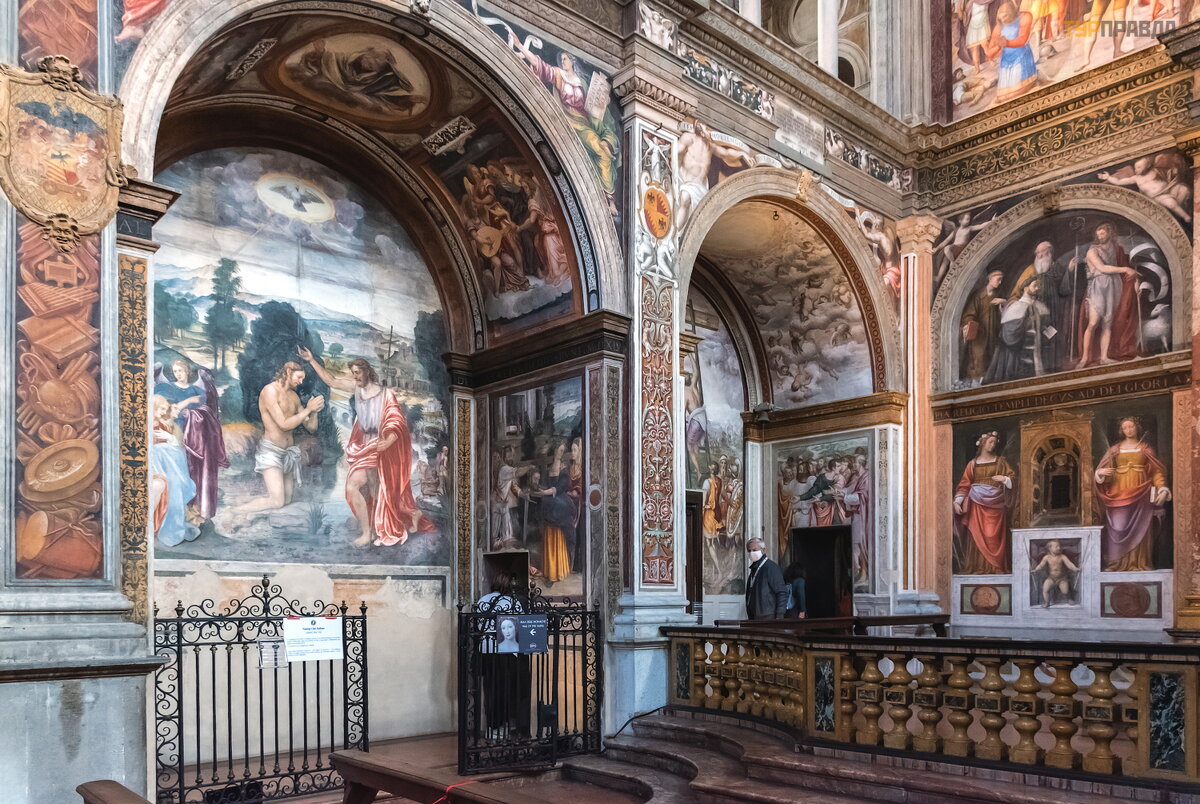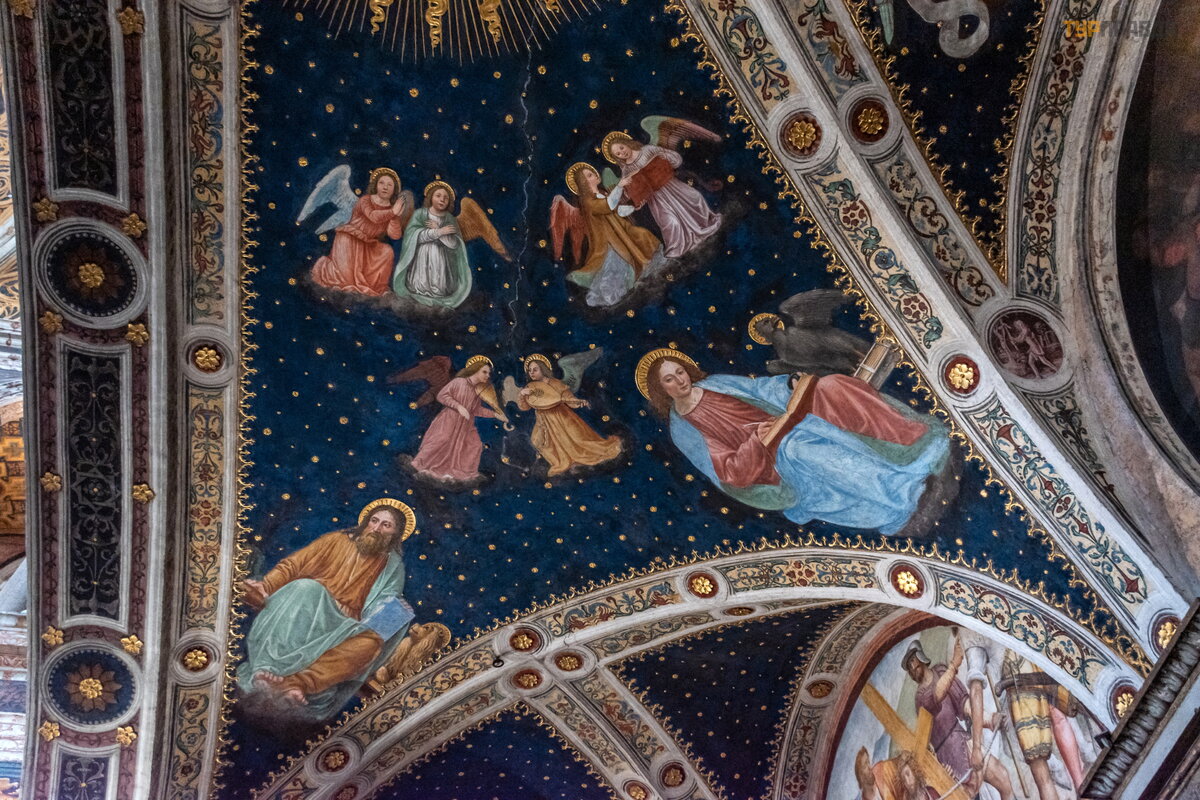Actually, I wasn't going to Italy this time… Milan. Continuation
Start here >>>
I'm coming back. The Church of Santa Maria delle Grazie is finally open. Only there is so little light in it that it is almost impossible to photograph, one might say, useless.
In principle, in all the churches that I visited on this trip, it was twilight, I photographed almost blindly, not really hoping that later I would be able to pull something out of the footage.
A bit of history: The monastery complex to which the church belongs was built in the second half of XV c. architect Guiniforte Solari by order of the Duke of Milan, Francesco I Sforza – in the place where the chapel dedicated to St. Mary of the Grazie used to be , to the Virgin of Mercy. The next Duke of Milan - Lodovico Sforza - decidel to turn the temple into a family tomb and invitel the then-famous architect Donato Bramante to renovate the temple.
The architect enlarged the building, crowned it with a new dome and rebuilt the chancel.
 Details of the decoration of the apse from the outside
Details of the decoration of the apse from the outside
 Lunette above the main entrance
Lunette above the main entrance
If Solari built the church in the Gothic style, then Bramante gave the temple features of the Romanesque style.
Curious: A tunnel was dug between the church of Santa Maria delle Grazie and the Sforza family castle.
From the middle of the 16th century. in the Church of Santa Maria delle Grazie, the meetings of the Inquisition Court, which was ruled by Dominican priests, were held. The court was abolished in 1785, when Milan was under the rule of the Habsburgs.
 Coronation of the Virgin, 1632
Coronation of the Virgin, 1632
Next to the church, at 65 Corso Magenta, is the house of Atellani.
 The church is reflected in the glass of the Atellani house
The church is reflected in the glass of the Atellani house
A bit of history: This was a family of courtiers and diplomats who served the Dukes of Sforza. In 1490, Duke Lodovico Moro presented the head of the family with a gift of two adjacent buildings with a garden on the street Borgo delle Grazie, today th Corso Magenta. The heirs of the family lived in the mansion until the 17th century. , after the house had other owners, but its name has been preserved. And the house of Atellani is famous for the fact that in 1498 the Duke Lodovico Moreau presented the great Leonardo with a vineyard - as a token of gratitude for many years of service - a huge plot, part of of which was in the territory of the current garden of the Atellani house.
Curious: After the death of the artist, the vineyard was forgotten for four centuries. And suddenly, during the restoration of the building destroyed in 1943, not only the plan of the vineyard was found, but also organic material was discovered, with the help of which the scientistssuccessfully recognized the DNA of the grapevine (by analyzing the soil and miraculously studying surviving roots), which was grown by Leonardo himself: it turned out to be Malvasia di Candia Aromatica. In 2015, the seeds of "that" grapes were planted again, and in 2018 the first harvest. em>
Now there is a museum La Vigna di Leonardo (Vineyards of Leonardo da Vinci).
Judging by the reviews and photos on the Internet, the place is very interesting and incredibly beautiful.
You can get there, according to the information on the website, as part of a group, having previously booked a time. Perhaps there are some remnants of tickets that can be purchased directly at the box office, but I no longer became curious.
A few hundred meters from Santa Maria delle Grazie on Corso Magenta is the Chiesa di San Maurizio al Monastero Maggiore (Church of San Maurizio), which won my heart 6 years ago. The inhabitants of the city call it the Milan Sistine Chapel.
I've already told about her, so I'll just show the newly taken photos.
The last time we ran into the church, when we passed by, there were only a few visitors, no one limited the time. Now there were 2 people standing at the entrance, and I had to wait a bit - they let in several people, having previously scanned the QR code of the vaccination certificate for each.
All the walls inside are completely covered with bright paintings illustrating the lives of the saints, the history of the Passion of Christ, as well as the daily life of the courtiers (for example, portraits of members of the Bentivoglio family, a powerful family that paid for most of the decorative elements in this temple).
They were allowed to move from the parish to the monastic part only when all the visitors left from there. And then they pointedly looked at the clock, as if making it clear: "your time is up" (c).
Small digression: when I went to the door leading to the monastic part, the attendant standing there began to say something quickly to me. I apologized for not knowing Italian. In English, he babbled just as quickly, but when he saw my wide-open eyes, he asked where I was from. I am ashamed that I do not know English, but I confess - from Ukraine. In response, she heard: “I understand, you need to speak slowly. ”
Yes, slowly, please! Thank you!!!
 The cloister, from which the exit is directly to Corso Magenta
The cloister, from which the exit is directly to Corso Magenta
When I left the church, there were already 15 people in line at the entrance.
The next point was Chiesa di Sant'Alessandro in Zebedia (Church of San Alessandro in Zebedia, accent on last syllable). She is not the most famous, I read about her from one tourist, looked at photos on google maps... I became interested. Built into the route.
Fast with the camera,
I took a wrong turn along the way and got a little lost. I twisted the tablet with the map this way and that...
“If you can’t find some kind of church, you need to turn to the local elders - their generation is more pious, and, as a rule, they know their city better, ” I recalled my own thought, which more than once helped me out in Italy .
At that moment, a married couple so advanced in age that they seemed to be barely walking came out of the alley. And they barely spoke when answering my question. But they immediately indicated the direction.
In a small square in front of the church, there is an active party of young people - next door is the Faculty of Foreign Languages of the Milan State University.
The square in front of the church is so small that there is nowhere to go to take a beautiful picture of the building as a whole.
Trying to fit the church into one frame, I went into the arch of the house opposite. The gates were open, and I was attracted by the chic wooden... something like cabinets, standing against the walls of the arch. Having taken a picture, I looked into the courtyard with the hope of “examining” it closer. Aha! : )
“Private property, you can’t, ” a young man stopped me, appearing from somewhere around the corner.
When I got home, I googled, spurred on by curiosity. It turned out that I wandered into the courtyard of Palazzo Trivulzio Brivio Sforza.
Once this palace was famous for its chic parties, surrounded by luxurious furniture, beautiful tapestries and painted ceilings, and many candelabra that brightly illuminated the rooms of the palace. The festivities were served by waiters in golden liveries.
And the family also owned a magnificent collection of objects of history and art: “relics from the Roman era to the Renaissance, from the secret seal of Ludovico Sforza to the Cup of Nero, were scattered throughout the palace, among the rarities was the manuscript of Leonardo da Vinci, known like the Codex Trivulziano. All the relics and remaining works of art of the palace are now exhibited in the Castello Sforzesco Museums”.
But back to Chiesa di Sant'Alessandro in Zebedia.
Historical note: The church was built at the beginning of the 17th century, it was one of the first Baroque buildings in Milan. The idea of building is associated with Cardinal Federigo Borromeo (he also founded the Ambrosianlibraryy).
Dedicated to Saint Alessandro, a Roman legionary who lived at the beginning of the 4th century Having converted to Christianity and becoming a preacher, he refusedto worship pagan deities, for which he was captured and executed.
If you look closely at the facade of the church, you will notice that two styles are combined in it: the Renaissance - strict symmetry and rectangularity of forms in the lower part, and plasticity, curvature of baroque lines in the upper tier (tympanum and bell towers).
Unfortunately, it was so dark inside that I couldn't even see it.
Whether there is always such lighting, or the Italians are now saving electricity, but the light fell pointwise:
on the pulpit in the center, decorated with precious stones,
a luxurious kiot with the image of the Virgin Mary and some chapels.
I can't even remember the altar, "inmade of colored marble, precious and semi-precious stones, it is considered one of the richest in Milan".
Honestly, because of the twilight, the desire to stay in the cathedral for a long time disappeared, and I went to the third church - Santa Maria presso San Satiro. Before it, from San Alessandro in Zebedia, two small blocks along Via Torino.
I learned about San Satiro 6 years ago - unfortunately, only after returning from a trip to Como and Maggiore. Otherwise, walking then along Via Torino, we would definitely go inside.
The church is located in a small courtyard, sandwiched between houses, and if you do not know about it, it is easy to pass by without noticing. A Romanesque bell tower of the 10th century adjoins the temple from the back side. - one of the oldest in the city.
Santa Maria presso San Satiro is called the pearl of the Renaissance and one of the masterpieces of Donato Bramante. It was the first work of an architect who had just recently arrived in Milan from the provinces.
A bit of history: In the 9th c. Archbishop Ansperto da Biassono dedicated a small chapel to a Milanese saint named Satir, brother of Saint Ambrose, patron of Milan.
In 1480, next to the chapel it was decided to build a new church in honor of the Virgin Mary. Santa Maria presso San Satiro means Saint Mary near Saint Satiro. The project was entrusted to the then little-known, but already promising, architect Bramante. Having a very small area at his disposal, Bramante manages build a temple with three naves, creating the illusion of perspective and depth inside.
He painted the altar in such a way that the vault of the apse, only 90 centimeters deep, seems more voluminous and deeper.
Bramante's later ingenious solution would become known as the trompe l'oeil style and would be widely used in Baroque architecture.
Curious: There is a medieval legend associated with the fresco that adorns the main altar. A young man, apparently suffering from a mental disorder, slashed a fresco of the Madonna and Child with a knife. And suddenly real blood flowed from the fresco.
The image in the lunette above the icon illustrates this story.
There are crowds of people on Via Torino. This is one of the oldest shopping streets in Milan, where various workshops and shops were once located. Now there are shops of inexpensive Italian and world brands: KIKO, Tezenis, ZARA, Guess, Terranova, Alcott, Tally Weijl and others.
But even in pre-Covid times, I don't remember so many people on the street.
The time is inexorably approaching at 18.00. And I also wanted to run away to photograph the beautiful octagonal bell tower of the Church of St. Gotthard and look at Piazza Mercanti: maybe this time I will be able to check the acoustic effect, which appears only at a certain point in the square. ; )
I even forgot about food, and there is no time left to go somewhere to eat either.
Remembering that "all roads lead to Rome", that is, to the Milan Cathedral, and from it to the Sforza Castle straight Via Dante, turn to the Duomo. It is very close, but I still dive into small streets, hoping to see something interesting.
There are even more people on the square in front of the cathedral. There are rides around, open areas of cafes, a musical group is playing somewhere... My head is spinning from the noise and flickering, I even get a little lost, trying to find a way out of there. : )
The impression that all the inhabitants of Italy came to Milan for the weekend.
I'm rushing to the Sforzesco. Somewhere along the way, three young ladies slow me down, asking me to take a picture of them together. Obviously, noticing the camera in my hands, they thought that I had experience in this. Naive!
I’m flying through the castle, taking pictures of the back side (“the wedding cake” against the background of the central tower has already become familiar):
And exactly at 18.00 I go to the bus...
To be continued…
P. S. For the whole day I took 15.5 thousand steps. Total.






















































































































Vasyusha, thank you. I'm glad you liked the photos. I hope that those that I will show next will not disappoint either.
The only city in Italy to which I breathe unevenly - from those where I have already visited - Florence. She hooked me from the first minute. We just drove into it by bus, and I was already fascinated. :)
vasyusha, спасибо. Рада, что фото Вам понравились. Надеюсь, что и те, что я буду показывать дальше, тоже не разочаруют.
Единственный город в Италии, к которому я неровно дышу - из тех, где уже побывала - Флоренция. Она зацепила меня с первых минут. Мы только въезжали в него на автобусе, а я уже была очарована. :)
c.conka2014, all gadgets were charged the night before. I already have the experience of "I'll fly - I'll charge at the hotel", I taught it forever. :)))
c.conka2014, все гаджеты были заряжены накануне вечером. Опыт "прилечу - заряжу в отеле" у меня уже есть, научил навсегда. :)))
Vasyusha, thank you. I'm glad you liked the photos. I hope that those that I will show next will also not disappoint.
The only city in Italy, to which I breathe unevenly - from those where I have already visited - Florence. She hooked me from the first minute. We just drove into it by bus, and I was already fascinated. :)
vasyusha, спасибо. Рада, что фото Вам понравились. Надеюсь, что и те, что я буду показывать дальше, тоже не разочаруют.
Единственный город в Италии, к которому я неровно дышу - из тех, где уже побывала - Флоренция. Она зацепила меня с первых минут. Мы только въезжали в него на автобусе, а я уже была очарована. :)
Dear my readers! Girls, yesterday I planned to post a new part of the story - about my beloved Florence .. But ... :((((((((((((((((((((
I believe that we will stand and win. That we will still travel and we will tell each other about it. And that I'll post the whole story. It is already ready, I was going to publish it with one-two-day breaks.
Olyajan, Olga, there is no connection with you. I communicate with everyone either by phone, or in FB, or in viber. Please respond, we are experiencing how you are now.
Strength and invulnerability to our warriors! Glory to Ukraine!
Let even those who simply tacitly agree with the attack on our country burn in hell!!!
Дорогие мои читатели! Девчонки, вчера я планировала выложить новую часть рассказа – про любимую Флоренцию.. Но… :((((((((((((((((((((((
Я верю, что мы выстоим и победим. Что мы еще будем путешествовать и будем об этом рассказывать друг другу. И что я выложу весь рассказ. Он уже готов, я собиралась публиковать его с одно-двухдневными перерывами.
olyajan, Олечка, с тобой нет связи. Со всеми я общаюсь либо по телефону, либо в ФБ, либо в вайбере. Пожалуйста, отзовись, мы переживаем как у вас сейчас.
Сил и неуязвимости нашим воинам! Слава Украине!
Пусть горят в аду даже те, кто просто молчаливо соглашается с нападением на нашу страну!!!
Dear my readers! Girls, yesterday I planned to post a new part of the story - about my beloved Florence .. But ... :((((((((((((((((((((
I believe that we will stand and win. That we will still travel and we will tell each other about it. And that I'll post the whole story. It is already ready, I was going to publish it with one-two-day breaks.
Olyajan, Olga, there is no connection with you. I communicate with everyone either by phone, or in FB, or in viber. Please respond, we are experiencing how you are now.
Strength and invulnerability to our warriors! Glory to Ukraine!
Let even those who simply tacitly agree with the attack on our country burn in hell!!!
Дорогие мои читатели! Девчонки, вчера я планировала выложить новую часть рассказа – про любимую Флоренцию.. Но… :((((((((((((((((((((((
Я верю, что мы выстоим и победим. Что мы еще будем путешествовать и будем об этом рассказывать друг другу. И что я выложу весь рассказ. Он уже готов, я собиралась публиковать его с одно-двухдневными перерывами.
olyajan, Олечка, с тобой нет связи. Со всеми я общаюсь либо по телефону, либо в ФБ, либо в вайбере. Пожалуйста, отзовись, мы переживаем как у вас сейчас.
Сил и неуязвимости нашим воинам! Слава Украине!
Пусть горят в аду даже те, кто просто молчаливо соглашается с нападением на нашу страну!!!